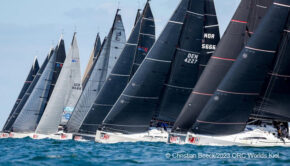Handicap Systems in the Free Market
Published on January 14th, 2016
In the absence of strong leadership in the US, there has been a parade of handicap systems that have sought the favor of race organizers. With the ORC system being introduced at 2016 Key West Race Week, Pete Reichelsdorfer, former chair of US Sailing ORR and IMS Committees, shares some history on handicap systems in the US…
It seems that the season for handicapping discussions is upon us. Here are a few thoughts on the Offshore Racing Rule (ORR).
ORR was established in America when US Sailing decided to exit the rule ownership business in order to accommodate the introduction of IRC to US Organizing Authorities in 2004. The rights of the then Americap II were ceded to a new organization called the Offshore Racing Association (ORA) and the rule name was changed to Offshore Racing Rule (ORR).
The ORA was formed by the association of three yacht clubs (CCA, Chicago and Transpac) who wanted a science based rule with local control. With financial help of generous donors, the Sailing Yacht Research Foundation provided the funds to overhaul and modernize the ORR VPP for the US fleet. The USA ORR fleet has grown to over 600 yachts as additional clubs have begun offering ORR as rule of choice.
In the US, handicapping systems operate in the free market and are selected by the individual race Organization Authorities (OA’s). US Sailing, the US National Authority, has not set any approval or guidelines. The USA, with its 20,000 PHRF and 600 ORR yachts is a fertile market for the two giant international rules – IRC and ORC.
IRC and ORC each have the funds and marketing power, including discount pricing, to infiltrate the market in the US. ORR certificates are tied to US Sailing and a set price.
Both international rules encourage optimization – IRC by way of its yearbook and ORC with its Open Access VPP. Optimization is goal of competitive sailors but is the bane of any rule. Any student of rating rule history will soon notice the demise of any rule is tied to rule beaters and undesirable yachts. Note that ORC introduced the ORCi Rule in 2008 with a new VPP to replace IMS.
ORR on the other hand is a Restricted Access rule. Only a small number of experimental certificates are allowed per year. The purpose of this is to deter optimization and promote rule stability. This concept is aimed directly at the bulk of the fleet rather that the Grand Prix level.
ORR can also supply constructed course handicaps on demand. The advantage of this concept is that the full power of the VPP can be applied for average predicted wind conditions. This is widely used by OA’ using ORR.
ORR is hampered in its marketing by lack of funds and has to rely on word of mouth advertising from OA’S and satisfied sailors. Please note that the original three clubs are still using ORR after more than 10 years and that various types of yachts have been able to visit the winners circle.
ORR is truly an American rule for American sailors. Locally owned and locally managed by fellow American sailors.
——————-
For the sake of clarification, Scuttlebutt Sailing News reached out to IRC and ORC for comment:
James Dadd, IRC:
Firstly, fees for IRC Certificates in the US are entirely in the hands of US Sailing. We do not offer discounts or incentives in the US; that is entirely up to US Sailing. ORC, on the other hand, offer the first certificate for free.
I am also not sure what optimization our Yearbook encourages. It does highlight that cleaning the hull and making sure you aren’t rated for bigger sails than you have (since they shrink over time) are good ideas, but I don’t think that is rating optimization. The basis of both ORR and IRC is that there are confidential elements that prevent optimization. In this manner, ORR and IRC work in very similar ways.
Dobbs Davis, ORC:
While the original founders of ORR remain committed to their rule, the free market for handicap systems evolved in 2015 to now include ORC, which previously had been actively blocked from use in the US. Now that the ORC is available in the US, the certificate pricing is set by US Sailing and not ORC.
It is true that the ORC rule has evolved, as most rules do (or should) to seek out improvements and upgrades in search of greater accuracy. As for optimizing, despite ORR and IRC being secret rules, they both have constituents that continue to seek the services of designers to improve their rating. Even US Sailing had been selling an ORR offshore race optimization package.
With regard to supplying constructed course handicaps on demand, ORC also does this – it’s common at all ORC Championship events.
The use of the ORC system in the US has just gotten started, but with 10,000 worldwide, it is the largest system, and it is this kind of member support that allows ORC to have a sustainable model to thrive in the free market.









 We’ll keep your information safe.
We’ll keep your information safe.